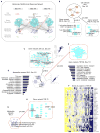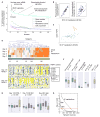Metabolic Phenotypes of Response to Vaccination in Humans
- PMID: 28502771
- PMCID: PMC5711477
- DOI: 10.1016/j.cell.2017.04.026
Metabolic Phenotypes of Response to Vaccination in Humans
Abstract
Herpes zoster (shingles) causes significant morbidity in immune compromised hosts and older adults. Whereas a vaccine is available for prevention of shingles, its efficacy declines with age. To help to understand the mechanisms driving vaccinal responses, we constructed a multiscale, multifactorial response network (MMRN) of immunity in healthy young and older adults immunized with the live attenuated shingles vaccine Zostavax. Vaccination induces robust antigen-specific antibody, plasmablasts, and CD4+ T cells yet limited CD8+ T cell and antiviral responses. The MMRN reveals striking associations between orthogonal datasets, such as transcriptomic and metabolomics signatures, cell populations, and cytokine levels, and identifies immune and metabolic correlates of vaccine immunity. Networks associated with inositol phosphate, glycerophospholipids, and sterol metabolism are tightly coupled with immunity. Critically, the sterol regulatory binding protein 1 and its targets are key integrators of antibody and T follicular cell responses. Our approach is broadly applicable to study human immunity and can help to identify predictors of efficacy as well as mechanisms controlling immunity to vaccination.
Keywords: Zostavax; herpes zoster vaccine; immune response; metabolomics; multiscale; shingles; systems biology; transcriptomics.
Copyright © 2017 Elsevier Inc. All rights reserved.
Figures







References
-
- Ben-Dor A, Shamir R, Yakhini Z. Clustering gene expression patterns. Journal of computational biology : a journal of computational molecular cell biology. 1999;6:281–297. - PubMed
MeSH terms
Substances
Grants and funding
LinkOut - more resources
Full Text Sources
Other Literature Sources
Molecular Biology Databases
Research Materials

